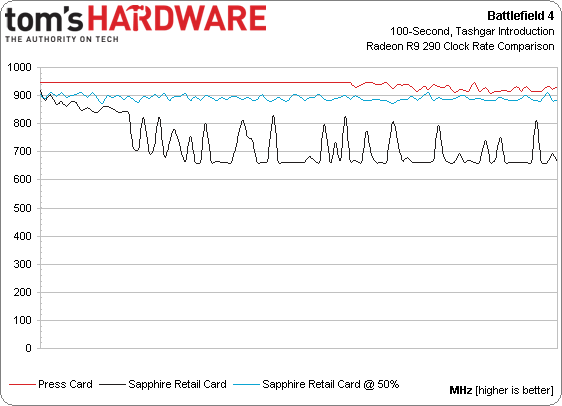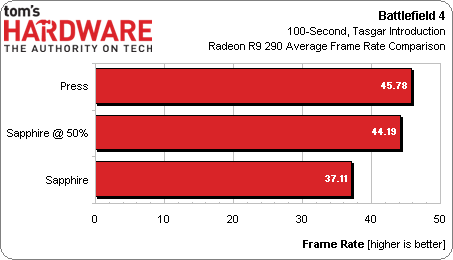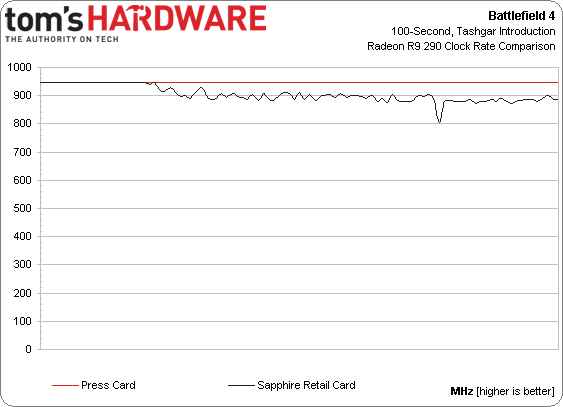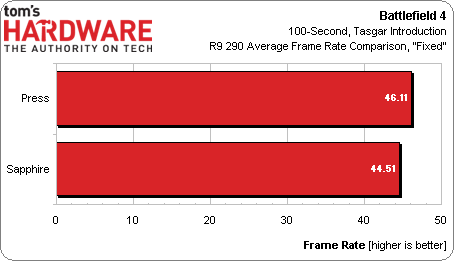The Cause Of And Fix For Radeon R9 290X And 290 Inconsistency
We first observed differences between the Radeon R9 290X cards that AMD sent out for review and the ones being sold online just before our R9 290 coverage went live. After additional testing, we have answers, feedback from AMD, and more questions.
Radeon R9 290 Gets The Same Treatment
If you saw our R9 290 coverage on Tuesday and decided that a $400 card delivering almost as much performance as the $550 Radeon R9 290X sounded tasty, then you were probably disappointed that we refrained from drawing a definitive conclusion about the press board’s representativeness. Let’s see if that trepidation was justified.
At launch, using Catalyst 13.11 Beta 8, Radeon R9 290 would spin up to about 2550 RPM under load, corresponding to a 47% PWM value. The same 47% on Sapphire’s R9 290 yielded just over 2300 RPM.
It’s no wonder, then, that Sapphire’s retail card bounced off of the board’s 662 MHz floor after just a few seconds of gameplay. By the end of a 100-second run, we recorded an average core clock rate of 726 MHz.
Manually scaling the card’s fan speed up to match our press board required a 50% PWM setting. But even at the same 2550 RPM, we were only seeing an average of 891 MHz compared to the press card’s 939 MHz.
Plotting out average performance shows us that the press-sampled R9 290 is 23% faster than our retail card. That’s exactly what I was afraid of, and the reason we held off on a judgment.
However, the new beta driver also imposes a new fan speed target on R9 290 as well. Instead of aiming for 40% PWM, like AMD originally planned, or 47%, which it later updated through software, it’s now aiming for 2650 RPM (more than 300 RPM faster than our retail card and about 100 RPM faster than our press board).
With Catalyst 13.11 Beta 9.2 installed, the press card maintains a fairly flat fan speed, while the retail board encounters strange spikes above 2700 RPM before tapering off and repeating itself.
Get Tom's Hardware's best news and in-depth reviews, straight to your inbox.
Clock rates certainly do come closer together, though. AMD's press board has zero trouble maintaining its 947 MHz peak clock rate. Meanwhile, the retail R9 290 from Sapphire averages 904 MHz. That's not quite as good, but it beats the hell out of the 726 MHz it was averaging right out of the box and the 891 MHz it managed after we manually goosed its fan to 50% PWM.
As frame rates go, the retail 290 pulls within 3.5% of our press board, which is the sort of variance AMD originally told us to expect.
Making Things Right
Am I at least satisfied that whatever oversight resulted in retail cards shipping out at varying degrees of lower performance is being actively addressed by the team at AMD? Yes; now gamers are getting the performance that got them so excited when these cards first launched.
Catalyst 13.11 Beta 9.2 makes Radeon R9 290X a little louder as it adds about 100 RPM to the "Quiet" mode we originally reviewed. The difference is noticeable, but I don't think gamers lacking headphones will be perturbed by the sound. But the R9 290 was already loud. So picking up an additional 100 RPM, even after AMD cranked the PWM from 40 to 47% prior to launch, is detrimental.
The bad news is that I really couldn't imagine buying an R9 290 equipped with AMD's reference cooler, particularly in light of today's update that adds even more fan speed and noise. The good news is that I have now have higher hopes for third-party 290s. With Catalyst 13.11 Beta 9.2, our Sapphire Radeon R9 290 is just as fast as Asus' Radeon R9 290X, tested on the previous page. If we could just get our hands on more aftermarket cooling solutions, I'm pretty sure we could chip away at the most compelling reasons not to buy these boards today.
-
tttttc I never understand why ANYONE will buy the reference design cards.... even for the GTX780, the aftermarket cooler is way better and quieter than the stock fan.Reply -
eldragon0 Thank you so much for this article, I've been waiting on a write-up of this sort. There is one thing I'd love to see. Assuming the 290 and the 290x have the same layout, is it possible for you to strap that aftermarket heatsink onto each of them and give us a comparison of both of them at retail without them being horribly throttled? I'd love nothing more than to see a 290 and a 290x head to head at full speeds !Reply -
itzsnypah Reply11889637 said:This kind of thing is why I use msi afterburner. Just set your own fan curve.
That is not how powertune works.
It's: Get Hot -> Get loud -> Drop clocks -> Get as loud as necessary to keep GPU from melting.
So having a 'custom' fan curve does nigh nothing.
E: I wonder what would happen if you fed the card hot air. What happens when you're at 100% fan speed and still pushing 96c+? Does it shut down, clock down even more or melt? -
FormatC Replyis it possible for you to strap that aftermarket heatsink onto each of them
It is impossible. The reason is simple: thermal clue. As I wrote in my article about the thermal grease: after the burn-in it is nearly impossible to remove the small heatsinks. The risk to destroy the card is too high. This aftermarket cooler is good and quiet but it is a real one-way ticket. You can't return ;)
For addition - I've done the same thing with R9 290 cards and another benchmark before AMD has changed the driver. We worked hard to detect the reason for this big variances. But it seems that the difference between the R9 290 cards is a little bit smaller.
This was before:
-
Quaddro Praise this card..Reply
Now we can see 780Ti and 780 with more reasonable price..;)
Still waiting msi hawk version or directCu version of both of this card..hope that series will handle the heat..
Spend $100 more just for cooler (mk-26 + 2 fans) on reference card, is not a really good option.. -
Nintendo Maniac 64 I wonder if the rest of the performance difference now boils down to how the stock thermal paste was applied.Reply -
FormatC This I've tested too. No mentionable differences. May be my cards were assembled by a very accurate robot ;)Reply
The voltage is a little bit different:
But this is not strange. Typical tolerance. -
iam2thecrowe I cant stand all this variable clock rate BS ever since it was introduced in nvidia and amd cards. the card throttles in the most demanding scenario's, where you need it not to throttle, so the "boost clock" speeds are just there to inflate benchmark figures without any improvement in real world performance. On my cards, i force a stable clock speed with Nvidia inspector, negating boost clock, games run more stable and predictably, the way it should be.Reply
p.s. the add for nail fungus you have on your page toms, nearly made me vomit. please no more nail fungus adds!!!!!!!






